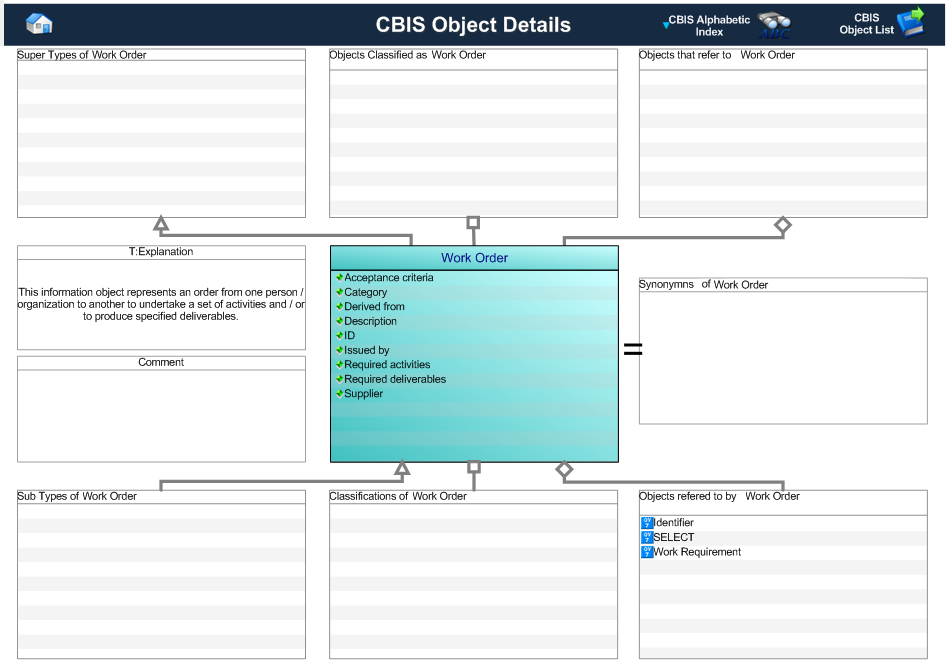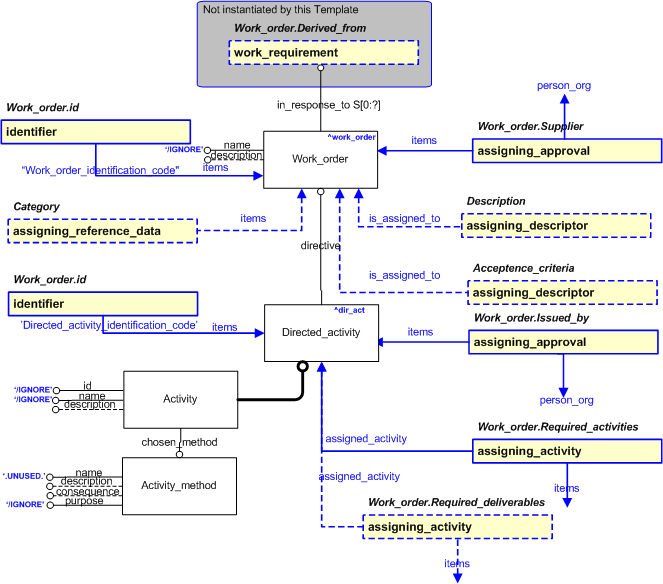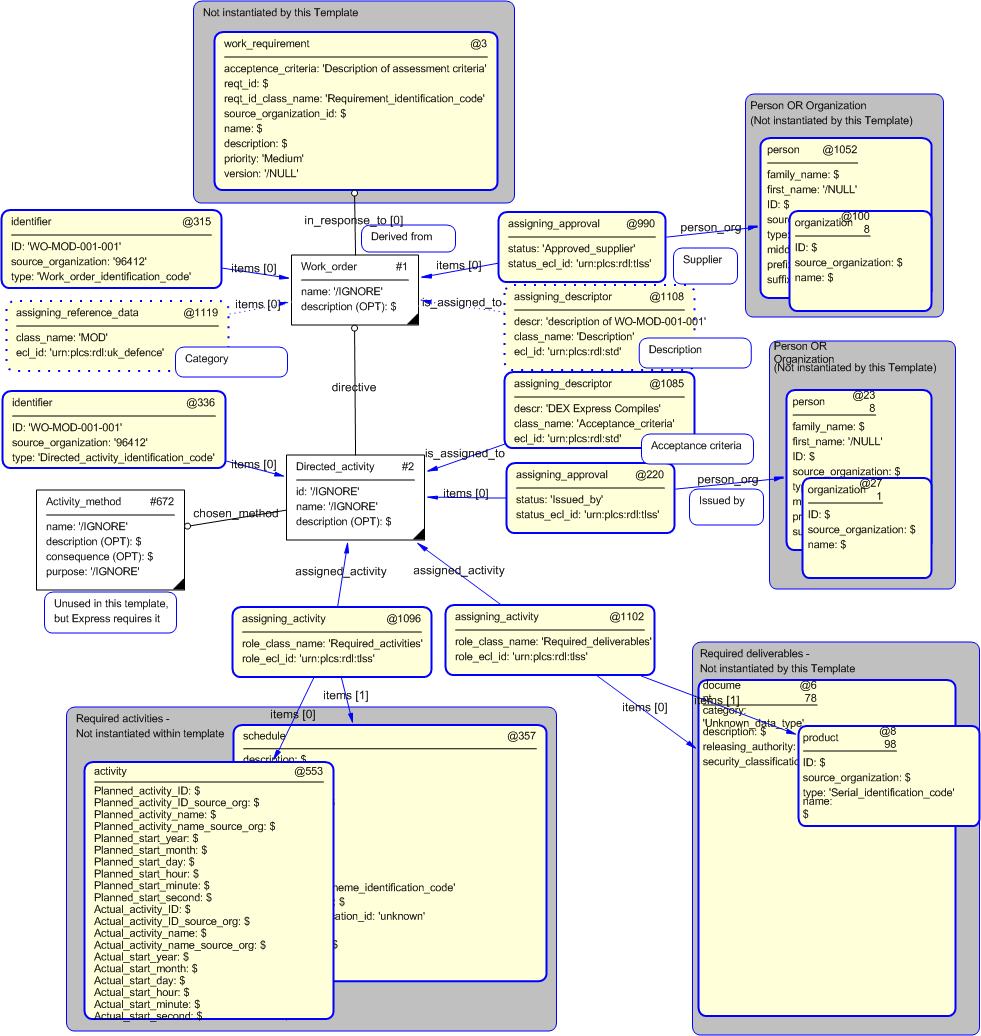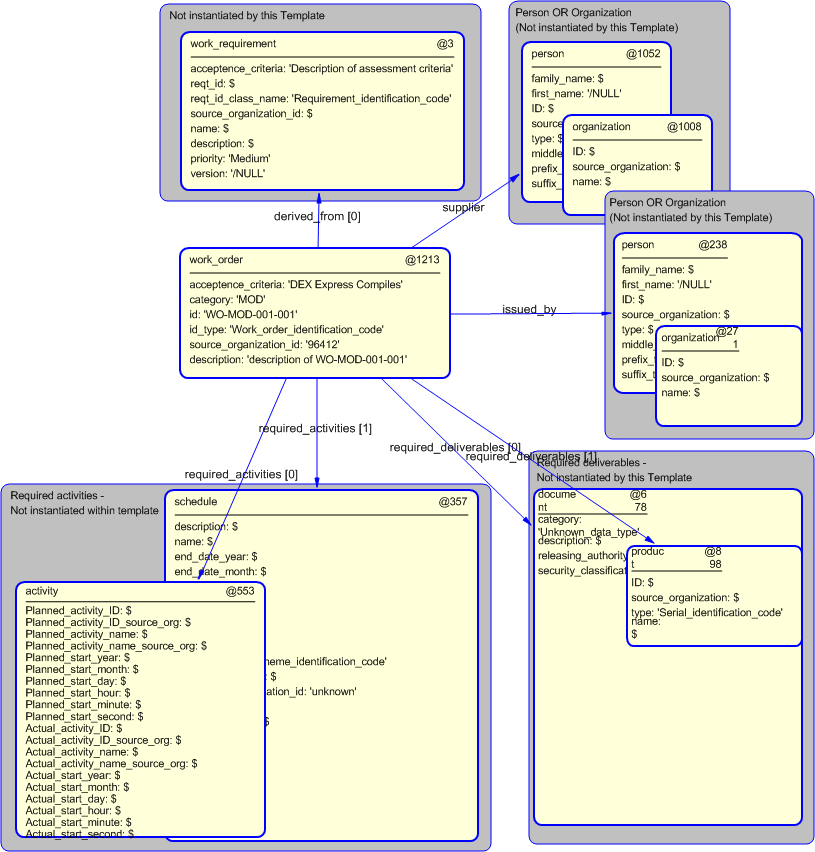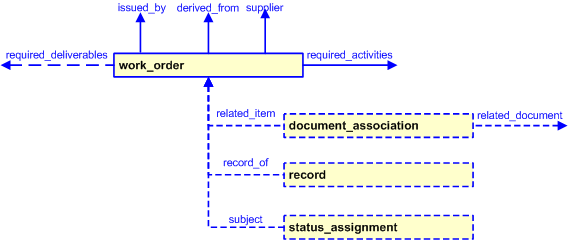Template:— work_order (wrk_ord)
Context:— UK_Defence |
Date: 2009/09/21 20:13:14
Revision: 1.4
|
This section specifies the template work_order.
NOTE
The template has been defined in the context of
UK_Defence.
Refer to the business context for details of related templates.
NOTE
An explanation of a template and the associated instantiation path is
provided in the
Template overview
section.
This template describes how to represent the information requirements of a UK_Defence Work Order object. A Work Order object
represents an order from one person / organization to another to undertake a set of activities and / or to produce specified
deliverables.
Work Orders are typically authorized (issued) schemes of work items (tasks and activities), as the result of a requirement
(to address an issue/problem)and may have a list of product deliverables (the output of the work).
This information object represents the information about a Work Order.
Figure 1 — A MOOD Business Architect representation of the Business Object: Work Order
The attributes of the Work Order object are tabled below.
|
Attribute name
|
Attribute description
|
Attribute type
|
Optionality
|
| Acceptance criteria |
This is the description of the criteria by which the work / deliverables will be accepted. |
Intrinsic |
Optional |
| Category |
This is the category of the work order.
- EXAMPLES:
- "Engineering Instruction",
- "Special Technical Instruction", (STI)
- "Urgent Technical Instruction", (UTI)
- "?? Technical Instruction" (RTI),
- "Modification", (MOD)
|
Intrinsic |
Optional |
| Derived from |
This is the reference to the work requirement from which the work order may be derived. |
Relationship to Work requirement |
Optional |
| Description |
This is the description of the work order. |
Intrinsic |
Optional |
| ID |
This is the identifier of the the work order. |
Identifier |
Mandatory |
| Identifier.id |
This is the value of the id attribute of the Identifier applied to the Work order |
intrinsic |
Mandatory |
| Identifier.type |
This attribute is the type associated with the id of the Identifier given to the Work orderThis must be one of the classes
provided.
|
Work_order_identification_code |
Mandatory |
| Identifier.source_organization |
This attribute is the value representing the source organization that provides the id of the Identifier given to the Work_order.
This value is assumed to be a type of Organization_identification_code.
|
Organization_identification_code |
Mandatory |
| Issued by |
This is the reference to thr person / organization that issued the work order. |
Relationship to Person, and/or Organization |
Mandatory |
| Required activities |
This is the reference to the activities that are required to be performed by the supplier under the work order. |
Relationship to Activity, or Schedule (of Activities) |
Mandatory (1:?) |
| Required deliverables |
This is the reference to the deliverables that may be required to be made by the supplier under the work order. |
Relationship to Document, or Product |
Optional (0:?) |
| Supplier |
This is the reference to the person / organization that acts as supplier with respect to the work order. |
Relationship to Person, and/or Organization |
Mandatory |
Table 1 — Work Order attribute details
The EXPRESS-G diagram in
Figure
2
shows the templates and EXPRESS entities that are required
to represent the template
"work_order".
The text highlighted in blue shows the template parameters.
Figure 2 — An EXPRESS-G representation of the Information model for work_order
The graphic for the template to be used in other EXPRESS-G diagrams
is shown in Figure
3
below.
Figure 3 — The graphical representation of the work_order template
The following input parameters are defined for this template:
The description of the acceptance criteria.
The category of the work order.
The following classes and their sub-classes can be used:
classifications: [Work_order_category]![[warning:]](../../../../../../images/dex/warning.gif) Error RDL4: The URI urn:plcs:rdl:uk_defence is not listed in dexlib/data/refdata/rdl_index.xml
Error RDL4: The URI urn:plcs:rdl:uk_defence is not listed in dexlib/data/refdata/rdl_index.xml
id_type (Default=Work_order_identification_code,Type='CLASS')
The name of the class used to classify the identifier and so
provide the role or reason for the identification.
The following classes and their sub-classes can be used:
The identifier of the organization that
"owns" the identifier.
The description of the work order.
The person or organization responsible for the approval.
This is the reference to the deliverables that may be required to be made by the supplier under the work order.
The person or organization responsible for the approval.
The following reference parameters are defined for this template:
Allow the
Work_order
entity instantiated in this path to be referenced when this template is used.
Note: The
Work_order
entity can be referenced in a template path by:
%^target = $work_order.work_order%
where
target
is the parameter to which the
Work_order
is bound.
Allow the
Directed_activity
entity instantiated in this path to be referenced when this template is used.
%^target = $work_order.dir_act%
Allow the
Activity_method
entity instantiated in this path to be referenced when this template is used.
%^target = $work_order.act_method%
The instantiation path shown below specifies the entities that are to be
instantiated by the template.
A description of templates and the syntax for the instantiation path is
provided in the
Templates Help/Information section.
-- Instantiate a Work_order Work_order-- [Optional Derived_from (links the work_order to the work_request)] Work_order.in_response_to ->
@derived_from-- Bind the Work_order to the parameter ^work_order. -- The parameter is a reference parameter so the Work_order -- entity can be referred to when this template is used. %^work_order =
Work_order%
^work_order.name = '/IGNORE'
^work_order.description = '/IGNORE'
-- [optional category] /
assigning_reference_data(
items=^work_order,
class_name=@category,
ecl_id='urn:plcs:rdl:uk_defence')/
-- Identify the Work_order /
identifier(
items=^work_order,
ID=@id,
type=@id_type,
source_organization=@source_organization_id)/
-- [Optional description] /
assigning_descriptor(
descr=@description,
class_name='Description',
ecl_id='urn:plcs:rdl:uk_defence',
is_assigned_to=^work_order)/
-- Approved Supplier of the Work_order /
assigning_approval(
status=’Approved_supplier’,
status_ecl_id='urn:plcs:rdl:uk_defence',
items=^work_order,
person_org=@supplier)/
-- [Optional Acceptance_criteria] /
assigning_descriptor(
descr=@acceptence_criteria,
class_name='Acceptance_criteria',
ecl_id='urn:plcs:rdl:uk_defence',
is_assigned_to=^work_order)/
-- Instantiate a Directed_activity Directed_activity-- Link the Directed_activity to the work_order Directed_activity.directive ->
^work_order
Activity_method%^act_method =
Activity_method%
^act_method.name = '/UNUSED'
^act_method.purpose = '/UNUSED'
-- Link the Directed_activity to the UNUSED activity_method Directed_activity.chosen_method ->
^act_method
-- Bind the Directed_activity to the parameter ^dir_act. -- The parameter is a reference parameter so the Directed_activity -- entity can be referred to when this template is used. %^dir_act =
Directed_activity%
^dir_act.id = '/IGNORE'
^dir_act.name = '/IGNORE'
^dir_act.description = '/IGNORE'
-- Identify the Directed_activity /
identifier(
items=^dir_act,
ID=@id,
type=’Directed_activity_identification_code’,
source_organization=@source_organization_id)/
-- Authorized Issuer of the Directive /
assigning_approval(
status=’Authorized_issuer’,
status_ecl_id='urn:plcs:rdl:uk_defence',
items=^dir_act,
person_org=@issued_by)/
-- Required activities /
assigning_activity(
role_class_name='Required_activities',
role_ecl_id='urn:plcs:rdl:uk_defence',
assigned_activity=^dir_act,
items=@required_activities)/
-- [Optional Aggregate required_deliverables] /
assigning_activity(
role_class_name='Required_deliverables',
role_ecl_id='urn:plcs:rdl:uk_defence',
assigned_activity=^dir_act,
items=@required_deliverables)/
The following entities are instantiated with attributes as specified:
The instance diagram in Figure
4
shows an example of the EXPRESS entities and templates that are instantiated by the template:
/work_order(acceptence_criteria='DEX Express Compiles', category='MOD', id='WO-MOD-001-001', id_type='Work_order_identification_code', source_organization_id='96412', description='description of WO-MOD-001-001', derived_from='@3', issued_by='', required_activities='@553, @357', required_deliverables='@678', supplier='')/
(an illustration of the consolidated work_order template is shown in
Figure
5 below.)
Figure 4 — Entities instantiated by work_order template
The instance diagram in
Figure
5
shows the graphic symbol for the template that is to be
used in other instance diagrams. The example template is:
/work_order(acceptence_criteria='DEX Express Compiles', category='MOD', id='WO-MOD-001-001', id_type='Work_order_identification_code', source_organization_id='96412', description='description of WO-MOD-001-001', derived_from='@3', issued_by='', required_activities='@553, @357', required_deliverables='@678', supplier='')/
Figure 5 — Instantiation of work_order template
The following section details how the
work_order
template can be optionally characterized by assigning
other constructs to it. These are characterizations commonly
applied to the template. The ISO 10303-239 EXPRESS model may enable
other assignments to the entities instantiated by the template.
The EXPRESS-G diagram in Figure
6
shows the possible characterizations of the template
"work_order".
Figure 6 — Characterizations for work_order
The following characterizations may apply:
Characterization Document Association
NOTE this characterization is optional.
A UK_Defence.work_order
may have specific documents assigned to it, through the use of the following templates (or those based upon these): UK_Defence.document_association
, and the associated UK_Defence.document
. The following template calls show how these characterizations
might be instantiated.
/document_association(id='', type='', source_organization='', purpose='', related_document='', related_item='')/
Characterization Record
NOTE this characterization is optional.
A UK_Defence.work_order
may have a Record assigned to it, through the use of the following template (or others based upon this):
UK_Defence.record. The following template calls show how these characterizations
might be instantiated.
/record(record_of='#xx', ID='R123', ID_source_organization='UK_Defence', Storage_media='Cd_rom', Date_created_year='2008', Date_created_month='1', Date_created_day='24', Date_created_hour='13', Date_created_minute='10', Date_created_second='3', Date_stored_year='2008', Date_stored_month='1', Date_stored_day='25', Date_stored_hour='11', Date_stored_minute='59', Date_stored_second='0', Storage_location_id='RSL01', Storage_location_id_type='Location_assignment_role', Storage_location_id_org='UK_Defence', Storage_location_name='The Record Strorage Depot', Storage_location_description='Depot for storing records', Storage_location_latitude='0.0', Storage_location_longitude='0.0', Storage_location_address_id='1', Storage_location_address_street='Hoo Road', Storage_location_address_postal_box='$', Storage_location_address_town='Newtown', Storage_location_address_region='Rutland', Storage_location_address_postal_code='RT1 3BC', Storage_location_address_country='UK')/
Characterization Status Assignment
NOTE this characterization is optional.
A UK_Defence.work_order
may have one or more status assigned to it, through the use of the following templates (or those based upon these):
UK_Defence.status_assignment.
The following template calls show how these characterizations
might be instantiated.
/status_assignment(assigned_status='', assigned_status_ecl_id='', ID='', ID_type='', ID_organization='', subject='', type='', type_ecl_id='')/
